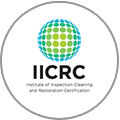If you’re concerned about the air quality in your home, it’s crucial to educate yourself about the most common type of mold. Mold is a type of fungus that thrives in damp environments and can cause health problems, particularly for individuals with allergies or weakened immune systems. By understanding prevalent mold varieties, you can take proactive measures to identify and rectify mold growth, promoting a safer and healthier living environment.
Mold growth is a pervasive issue and can affect every area of your home, including bathrooms, kitchens, and basements. Even if you can’t see mold growth, it’s essential to address it promptly to mitigate potential health risks. Keep reading to learn more about the common type of mold and how to identify prevalent mold varieties in your home.
Key Takeaways:
- Understanding the most common type of mold can promote a healthier living environment.
- Prevalent mold varieties include Cladosporium, Alternaria, Penicillium, Aspergillus, and Stachybotrys.
- Mold growth can occur in every area of a home, so it’s essential to check for mold growth regularly.
- Mitigating mold growth in a home can mitigate potential health risks associated with prolonged exposure to mold.
- Proactive measures, such as increasing ventilation and reducing moisture levels, can prevent mold growth.
Understanding Mold Growth
Before delving into the different types of mold, it’s crucial to understand how mold grows and the contributing factors. Mold spores thrive in environments with specific conditions, including ample moisture, warmth, and organic matter, such as wood or paper products.
The growth process usually starts with the development of spores on a surface and gradually progresses into a more extensive network of mold. As the mold grows, it releases microscopic spores that circulate throughout the air, potentially leading to respiratory issues when inhaled.
Factors contributing to mold growth include:
- Humidity: High levels of moisture in indoor environments can provide an ideal growing environment for mold spores.
- Poor Ventilation: Inadequate ventilation restricts air circulation and creates pockets of stagnant air that can lead to mold growth.
- Water Intrusion: Leaks from pipes, roofs, and windows can create moist spots that facilitate mold growth.
- Organic Materials: Wood, paper products, and other organic materials can feed mold growth.
Reducing the potential for mold growth requires reducing moisture levels and ensuring adequate ventilation in indoor spaces. Regular cleaning and prompt repair of any water damage can prevent the development of mold spores and keep indoor environments healthy.
Cladosporium – The Most Common Mold
If you’re concerned about mold in your home, it’s essential to understand the most common types of mold. Cladosporium mold is prevalent in indoor environments, and it can lead to various health concerns if not adequately addressed.
Cladosporium mold is a slow-growing mold that can appear in various colors, including green, gray, brown, and black. It thrives in damp areas and can grow on a variety of surfaces, including wallpaper, carpet, and insulation.
If you suspect you have Cladosporium mold in your home, the first step is to identify it. Look for signs of discoloration and a musty odor. It’s also essential to monitor any areas that have experienced water damage or high humidity levels, as these are prime locations for mold growth.
If you’re not sure whether you have Cladosporium mold or another type of mold, consider hiring a professional mold remediation company for a thorough inspection.
| Characteristics | Description |
|---|---|
| Color | Green, gray, brown, or black |
| Appearance | Slow-growing, fuzzy, and powdery |
| Preferred Habitat | Damp areas, including shower stalls, basements, and crawl spaces |
| Potential health effects | Allergic reactions, respiratory problems, and skin irritation |
Once you’ve identified Cladosporium mold, it’s essential to take steps to eliminate it from your home. Proper remediation requires identifying the source of moisture and eliminating it, repairing any leaky pipes or roofs, and ensuring adequate ventilation in high-humidity areas.
Remember, Cladosporium mold can have adverse effects on indoor air quality and your health, so it’s crucial to address it promptly and thoroughly.
Alternaria – Another Prevalent Mold Variety
Alternaria mold is another commonly found mold type in residential settings. It is a filamentous fungus that can grow in damp and humid conditions, such as bathrooms, kitchens, and basements. Alternaria mold appears as dark spots on surfaces and can also grow on wallpaper, textiles and building materials such as drywall or insulation.
Exposure to Alternaria mold can cause several health effects, especially for people with existing respiratory conditions. It can trigger asthma symptoms, such as coughing, wheezing, and shortness of breath. Prolonged exposure can result in chronic health issues, such as hypersensitivity pneumonitis, a type of lung inflammation caused by inhaling mold particles.
If you suspect that your home has Alternaria mold, it’s important to take prompt action. Wear protective gear while cleaning the area and remove all visible mold, including spores. You can use a solution of water and bleach to clean non-porous surfaces, but porous materials such as carpets and drywall may require replacement. Consider seeking professional mold remediation services for a thorough and safe removal process.
Penicillium – A Common Indoor Mold
Penicillium is a type of mold that can commonly grow in indoor environments, especially in areas with high humidity and moisture, such as bathrooms and kitchens. This mold can have adverse effects on indoor air quality and may cause respiratory problems in individuals with allergies or weakened immune systems.
To identify Penicillium mold in your home, look for green or blue fuzzy patches on surfaces like walls, ceilings, and floors. Penicillium mold has a velvety texture and can spread quickly if left untreated. It can also grow on household items such as furniture, carpets, and wallpaper.
Penicillium mold can release spores into the air, which can cause allergic reactions or respiratory problems when inhaled. It may also produce mycotoxins, which can be harmful to humans and pets. To prevent indoor Penicillium growth, maintain a dry and well-ventilated home, fix any leaks or water damage promptly, and clean and dry any wet surfaces or materials immediately.
Aspergillus – Significant Indoor Mold
If you’ve discovered mold in your home, Aspergillus is one of the varieties that shouldn’t be ignored. This indoor mold appears in different colors, including green, yellow, and white. If you have a weak immune system, you may be at a higher risk to the health threats that Aspergillus poses. Prolonged exposure to Aspergillus mold spores can significantly affect your respiratory system.
Aspergillus produces mycotoxins, which are considered dangerous to human health. Mycotoxins can cause respiratory difficulties, sinus infections, and sometimes lead to invasive aspergillosis, a life-threatening disease. Keeping a check on indoor humidity below 60% and ensuring proper ventilation can prevent Aspergillus mold growth in your home. Leaking pipes, roofs, or any other water damages should be addressed immediately to prevent ideal conditions for Aspergillus and other molds growth.
Identifying Aspergillus mold can be challenging because of its similar appearance to other mold varieties. You should contact professional mold testing and remediation services to determine if you have Aspergillus mold infestation in your home. Don’t attempt to handle the issue on your own as this can increase the risk of mold exposure and associated health risks.
Stachybotrys – The Infamous “Black Mold”
Stachybotrys, also known as “black mold,” is a greenish-black mold that thrives in areas with excessive moisture. It can grow on surfaces where water has accumulated, such as around leaky plumbing, or in areas with high humidity, such as bathrooms and basements.
The health effects of Stachybotrys mold on humans are a subject of concern and controversy. Some studies suggest that prolonged exposure to high levels of Stachybotrys spores may cause respiratory problems, such as coughing, wheezing, and asthma. Others suggest that it may also cause skin rashes, fatigue, and headaches.
To identify Stachybotrys mold, look for greenish-black mold growing on surfaces with excessive moisture. You may also notice a musty odor in areas where the mold is present. If you suspect the presence of Stachybotrys mold in your home, it is essential to consult with a professional to have it properly identified and removed.
Conclusion
In conclusion, understanding the most common types of mold and their characteristics is vital to maintaining a healthy living environment. By taking proactive measures to prevent and remediate mold growth, you can improve indoor air quality and safeguard your health.
Remember to keep an eye out for common mold types such as Cladosporium, Alternaria, Penicillium, Aspergillus, and Stachybotrys, and take appropriate action if you suspect their presence in your home.
Regularly inspecting your home for water damage, controlling indoor humidity levels, and ensuring proper ventilation can prevent mold growth and improve indoor air quality.
If you suspect mold growth in your home, contact a professional mold remediation specialist to help identify and resolve the issue. By prioritizing mold prevention and remediation, you can maintain a healthy living environment for you and your family.
FAQ
What are the most common types of mold found in homes?
The most common types of mold found in homes include Cladosporium, Alternaria, Penicillium, Aspergillus, and Stachybotrys.
How can I identify Cladosporium mold?
Cladosporium mold is typically olive green or brown in color and has a suede-like texture. It can be found on damp surfaces, such as fabrics, carpets, and wood.
What are the potential health effects of Alternaria mold?
Exposure to Alternaria mold can lead to allergic reactions, including respiratory symptoms like sneezing, coughing, wheezing, and itchy, watery eyes.
How does Penicillium mold commonly grow in homes?
Penicillium mold thrives in damp and humid environments, such as basements, bathrooms, and areas affected by water leaks or flooding.
What are the health risks associated with Aspergillus mold?
Aspergillus mold can cause respiratory infections and allergic reactions. It poses a higher risk to individuals with weakened immune systems or pre-existing respiratory conditions.
How can I identify Stachybotrys mold, also known as “black mold”?
Stachybotrys mold is typically dark green or black in color and has a slimy texture. It commonly grows on materials with high cellulose content, such as wood, paper, and drywall.
Why is it important to prevent and remediate mold growth?
Mold growth can negatively impact indoor air quality and pose health risks. Prevention and remediation are crucial to maintain a healthy living environment and safeguard your well-being.






